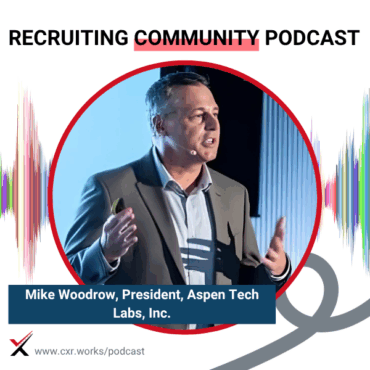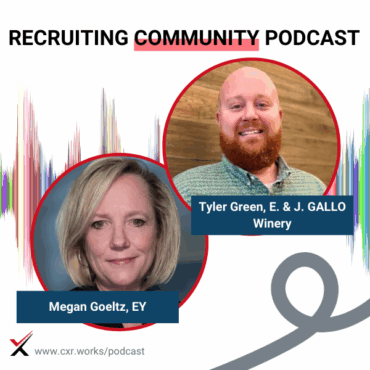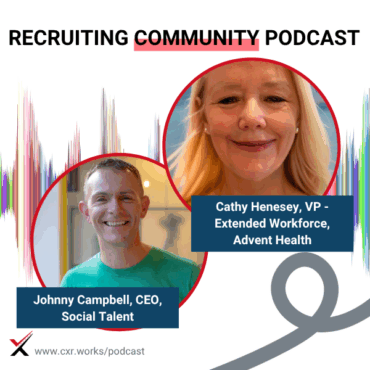
AI in Talent Acquisition
How are real TA leaders navigating AI? From legal hurdles to budget trade-offs, this episode explores the realities of automating hiring—without losing the human touch.
 play_arrow
play_arrow
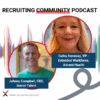 play_arrow
play_arrow
AI in Talent Acquisition Cami Grace
 play_arrow
play_arrow
Balancing Strategy and Tactics: Melissa Thompson’s Career Crossroads Cami Grace
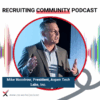 play_arrow
play_arrow
Real-Time Jobs Data and the TA Advantage Cami Grace
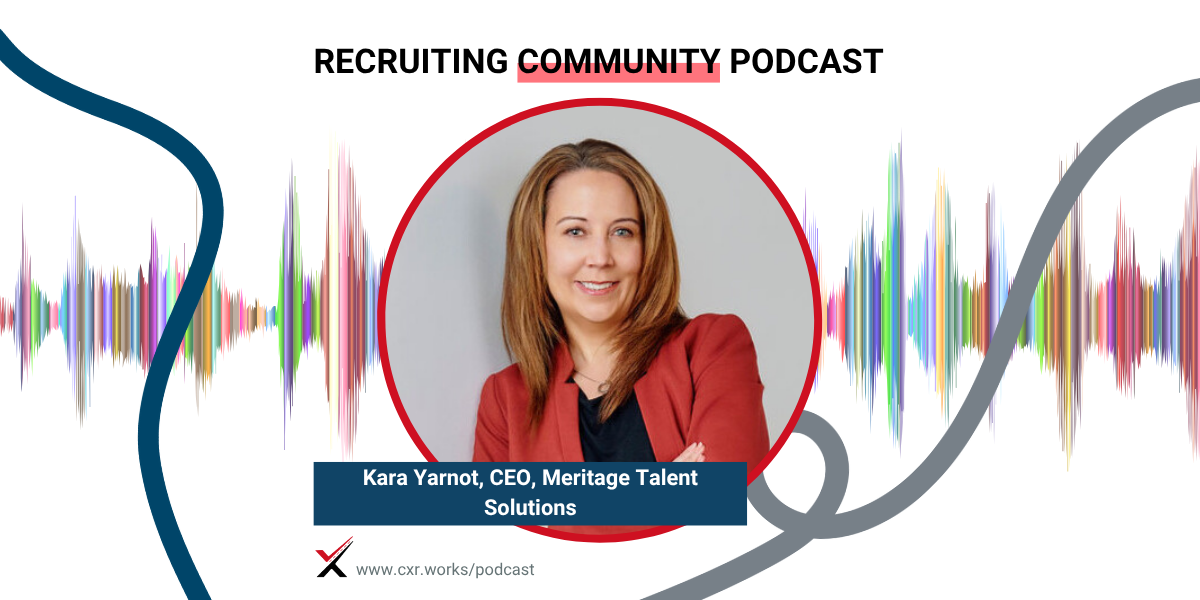
Featured Guests:
Kara Yarnot, Founder of Meritage Talent Solutions and Author of The Talent Trifecta: An Executive’s Guide to Attracting, Selecting, and Retaining Talent
Hosts:
Chris Hoyt, President, CareerXroads
Episode Overview:
In this episode, Chris Hoyt welcomes Kara Yarnot to discuss her 30-year journey in talent acquisition and the recent release of her book, The Talent Trifecta. The conversation explores how TA leaders can better align their messaging with executive priorities, use data strategically, and elevate talent strategies into core business discussions. Kara shares real-world insights from her consulting practice and offers practical advice for driving retention and engagement from the very first candidate interaction.
Key Topics:
The inspiration and purpose behind The Talent Trifecta
How to frame TA conversations in language executives care about
Using retention as a strategic entry point for TA influence
Common pitfalls TA leaders face when engaging senior leadership
Leveraging data to tell impactful stories, not just reports
The evolving role of TA in business strategy, especially with AI
Tools and diagnostics to support executive-TA collaboration
Notable Quotes:
“The part of the talent cycle that gets executives’ attention most is retention. Because it’s easily quantified.”
“Start your conversation with what matters to them, and then tie that back to what you need to do your job well.”
“There wasn’t a book written to the executives to help them understand how talent acquisition impacts business—so I said, ‘I guess I need to write that book.’”
Takeaways:
Kara Yarnot emphasizes the need for TA leaders to shift from internal process language to business-oriented dialogue. By starting with executive priorities like retention and productivity—and backing up proposals with targeted data—TA professionals can earn a stronger voice at the table. Her book serves as a guide to bridge this gap and encourage more strategic, results-driven partnerships between TA and leadership.
Want more conversations like this?
Subscribe to the CXR podcast and explore how top talent leaders are shaping the future of recruiting. Learn more about the CareerXroads community at cxr.works.
Chris Hoyt: All right. So Kara, I have known you—oh man. I’m going to try not to put any years on this. Dare I ask, did we meet… I was thinking about this earlier today. Did we meet when you were at Conference Board?
Kara Yarnot: I think we did meet then. So that’s been… 12 years?
Chris Hoyt: No…
Kara Yarnot: No…
Chris Hoyt: Oh man. We don’t have to put any numbers on it.
Kara Yarnot: Zip it.
Chris Hoyt: Yeah, yeah, yeah. It’s been a while. We’ve been—well, we’ve been in the space a bit. I’ve been doing this… I’ll name my own number so you don’t have to.
Kara Yarnot: No, I’ll add. It’s fine.
Chris Hoyt: So I’ve been in the space… coincidentally, I’m just over 30 years. CXR is 30 years old this year, which is kind of fun.
Kara Yarnot: Yay, CXR!
Chris Hoyt: Yeah! So I’ve been in the space just about that long.
Kara Yarnot: Same here. I became a recruiter for the first time in 1996, so I’ll hit my 30 years next year.
Chris Hoyt: Yeah—97 for me, I think.
Kara Yarnot: Okay. So yeah, we’re about the same. We’ll let the listeners do some math.
Chris Hoyt: They were told there would be no math.
Kara Yarnot: There you go.
Chris Hoyt: So it’s kind of a funny thing. I think we were talking about this in the green room before we got started—that there are these stages of life that we seem to go through. I have a theory. Tell me if this aligns with your experience.
Kara Yarnot: Okay.
Chris Hoyt: There’s this pattern—I think I’ve said this on the show before. So, college. All your friends are either getting out of college or out of the military, and suddenly they’re all getting married. Then there’s a phase where they’re all having kids. And then another phase where half of them are getting divorced.
Kara Yarnot: Yes.
Chris Hoyt: Sometimes you have to pick a team. Sometimes you can stay on both. Then some of them come out of the closet after the divorce and realize they have a different lifestyle ahead—and that’s fun and interesting to support. And now… some of them are having grandkids.
Kara Yarnot: Yes!
Chris Hoyt: And now we’ve got friends who are having weird health challenges. Like, their toe breaks in the morning. They didn’t bump it on anything. It just broke while walking. Weird stuff.
Kara Yarnot: Yes.
Chris Hoyt: Do you see the same thing?
Kara Yarnot: Oh, 100%. And you know, we were talking about what’s going on next year in 2026—I’ve got the weddings of the next generation. One of my dearest friends from college, a sorority sister I still see every six weeks like clockwork for breakfast—her son is getting married in October outside Cincinnati. And then my significant other’s nephew is getting married in April in Puerto Rico. So we’re at least making a tropical vacation out of that one.
So we’ve got two big weddings of the next generation—which is getting kind of crazy. And there have been other engagements happening recently too. So, yeah. It’s that next phase of life. We’re sure we’re still cool, but…
Chris Hoyt: Are we though? Are we cool?
Kara Yarnot: In our own brains.
Chris Hoyt: Yeah. I did leave the kids’ weddings out of that life phase. That’s a good call. Have you ever been in one of these conversations with the kids about all the “cool” things they say now?
Kara Yarnot: Oh, what do these things even mean? I don’t think we were this cryptic as teenagers. Maybe? I don’t know.
Chris Hoyt: I have a distinct memory of my mom asking me before a party, “Are you going to wear those O-P shorts?” I was horrified. I was like, “Mom, it’s O-P!” And she leaned in and whispered, “How do you know these things?”
Kara Yarnot: Oh no—we’ve become our parents.
Chris Hoyt: Yeah. So I asked my daughter—she came over for dinner the other week—and I said, “I heard a phrase, tell me if I’m saying it right: your makeup’s really eating your face.” She looked horrified. Apparently, you’re just supposed to say “your makeup is eating” or “your shoes are eating”—but not a particular body part.
Kara Yarnot: Oh. Just “eating.”
Chris Hoyt: I think so. But don’t hold me to that.
Kara Yarnot: Yeah. Probably best to not try.
Chris Hoyt: Yeah, maybe not. Well, I hear you’ve got a book that’s “eating.”
Kara Yarnot: Is it eating? Yes! I do have a book. If “eating” is good, then yes—it’s eating. My book is out!
Chris Hoyt: The Executive’s Guide to Attracting, Selecting, and Retaining Talent. The trifecta.
Kara Yarnot: The trifecta “eats!”
Chris Hoyt: There you go. We’ll let the kids tell us if we’re using that right.
Kara Yarnot: We’re just not in the cool kids club anymore.
Chris Hoyt: No. We’ll have to make our own club. God, I’m crying—we haven’t even started. You ready to get into this?
Kara Yarnot: Yes, let’s go.
Announcer: Welcome to the Recruiting Community Podcast, the go-to channel for talent acquisition leaders and practitioners. This show is brought to you by CXR, a trusted community of thousands connecting the best minds in the industry to explore topics like attracting, engaging, and retaining top talent. Hosted by Chris Hoyt and Gerry Crispin. We are thrilled to have you join the conversation.
Chris Hoyt: Welcome everybody to the Recruiting Community Podcast. I’m Chris Hoyt, your host. Every week we try to bring in TA leaders—folks who are doing the work, the practitioners in the space—people who are doing the lift, right? We talk about what’s top of mind for them, what’s keeping them up at night, and what they’ve been working on.
We’re honored to have a longtime industry friend here with us today—very excited. Just a reminder, cxr.org/podcast is where you can find past episodes. We typically livestream on LinkedIn, so if you’re watching there, drop questions in the chat—we’ll follow up and make sure to get back to everybody.
With all of that, I am excited to welcome Kara Yarnot to the show. Kara, welcome!
Kara Yarnot: Thank you, Chris. It’s so exciting to be here!
Chris Hoyt: We mentioned a little earlier—like, we’ve known each other for decades. Why don’t you give us a little elevator pitch? Who is Kara? And then let’s talk a little about your organization. Because you’ve written a book, and we’ve got some fun topics to hit. So, why should people stay tuned in?
Kara Yarnot: Sure. In my 30 years in talent acquisition, I started as a practitioner. I spent 17 years on the corporate side. And like many of us, I became a recruiter by accident. My first job out of college was with Intel in Folsom, California. I was a supply line planner, and they asked me to go back to my alma mater for a career fair. I was standing next to the recruiter, talking about how great it was to work at Intel, and I suddenly realized—wait, this is a job? I could do this?
Within a year, I made a career switch into TA and never looked back. I spent time with brands like Intel and Boeing—I led college and diversity recruiting there. I worked in construction with NVR, who builds under Ryan Homes and NV Homes. And my last corporate role was as VP of Talent Acquisition at SAIC, a Fortune 250 company. I had a team of about 250 recruiters.
After that, I moved into the vendor/consulting side, and I’ve now been doing that for about 13 years. My company is Meritage Talent Solutions. We provide strategic solutions for organizations of all sizes—everything from TA assessments, tech selection and optimization, EVP and brand work, process optimization, and more. I partner with tech providers and help organizations align solutions to their challenges.
Basically, I’m here to support TA and HR leaders with those strategic challenges they wish they had time and bandwidth for—because I’ve been in their shoes and I know the pressures they’re under.
Chris Hoyt: So you’ve seen some stuff.
Kara Yarnot: Oh, goodness, yes. And one of the joys of consulting is the wide range of industries I get to work with. I once went 1,700 feet underground into a mine! Just all kinds of amazing experiences.
Chris Hoyt: I’ll have to connect you with one of our members who just went into a mining company role. Really fascinating work in front of them.
Kara Yarnot: Yes!
Chris Hoyt: Well, look, congrats on the new book.
Kara Yarnot: Thank you!
Chris Hoyt: This got my lazy self thinking. When I saw it pop up, I thought, “You know what? We haven’t had her on. We should do this.” It is long overdue. So, I’m glad I saw it and that you were okay with coming on.
Can you give us a little bit of background on what inspired you to write it? And how it connects to the conversations TA leaders are having with executives today?
Kara Yarnot: Great question. What I found in my consulting practice is that the most successful projects happened when C-suite and executive leaders beyond the CHRO were involved—when they wanted to understand how talent strategies were impacting business outcomes.
Those were the projects where, when we came back 12–18 months later, the strategies were still in place, and the organizations were seeing results. So I started thinking: Where’s the book I can leave behind for them? Or send ahead of a project?
And what I found was: in our space, we’ve got a lot of smart HR and TA people writing books—for other HR and TA people. There wasn’t a book written to the executives to help them understand how talent acquisition impacts business.
So I said, “I guess I need to write that book.” I outlined it, put it aside, outlined it again… until I finally hired a book coach. Because I’m a consultant—I write in PowerPoint, not 250 pages of prose!
But with help, it came together. For me, it started with looking for a tool to help executives connect the dots. And I realized: I’ve already been doing this—so maybe I should write it down.
Chris Hoyt: I love it. I’ve been talking about doing something similar for years. I may tap you on the shoulder to ask about that experience.
Kara Yarnot: Let’s have a conversation. Now that it’s behind me, I can say: I could do this again. The next two books are already in my brain. But if you’d asked me while I was writing this one? I’d have said, “What did I get myself into?” Now I know the process. I can replicate it.
Chris Hoyt: I love that you’re not saying, “That’s it.”
Kara Yarnot: Nope. Not a one-and-done.
Chris Hoyt: So, part of what really interested me was your take on reframing conversations. When we use that phrase, what does that actually look like in practice for TA leaders heading into executive meetings?
Kara Yarnot: When TA execs go to talk with the C-suite, we’re usually thinking about what we want—more funding, more commitment, more something. So we tend to speak in TA language—branding, process, pipelines. But we need to reframe that into language that matters to them.
The part of the talent cycle that gets executives’ attention most is retention. Because it’s easily quantified. Turnover is expensive. Gallup says it costs 50–200% of someone’s salary to replace them. If you’re losing 200 people a year, at $50K average cost—that’s $10 million.
Chris Hoyt: That’ll get their attention.
Kara Yarnot: Right? So I tell leaders: start with retention. And when they say, “But you’re in TA—what do you have to do with retention?” The answer is: everything.
Retention starts with the first touchpoint in the attraction and selection process. We can show how TA directly impacts that. For example, if we’re promoting the wrong brand message or attracting the wrong candidates, people won’t stay.
If we’re putting the wrong people into manager roles, people won’t stay. And most companies promote based on tenure or individual contributor performance—not leadership skills.
So, you take a portion of that $10 million you’re losing, and invest it into better assessments, better branding, better processes—and you get real ROI.
You also reframe the conversation based on who you’re talking to. If it’s a COO—talk about efficiency and effectiveness. CMOs? Talk about the marketing rule of 7 and campaign reach. Always use their language and tie it to their KPIs.
Chris Hoyt: That’s an interesting callout. TA touches so many areas—like assessments or branding—but not every leader is pulling that up into these business conversations. It’s almost like we’re great chameleons for hiring managers, but we forget to do the same when we talk up the ladder.
Kara Yarnot: Exactly. And that’s a big part of why I wrote the book. I wanted executives to understand these things, and start asking better questions of their TA leaders. Because TA leaders are often being reactive, and they don’t get asked how they do what they do.
So the book gives execs a roadmap. There’s even a diagnostic on the book’s website that they can walk through with their TA leader. It’s all about opening that dialogue.
Chris Hoyt: I love it. So, we talked about reframing and language. What are some common mistakes TA leaders make when they try to bring executive priorities into the conversation?
Kara Yarnot: The biggest one? Not bringing data.
You need to bring numbers. But more importantly—bring your numbers. Show where bottlenecks are. Show how your process stacks up against others. If your brand isn’t converting, show that.
Executives are competitive. Show them you’re getting beat somewhere, and they’ll care.
But don’t stop there. Don’t just data dump. Tell the story with that data. Tie it to business outcomes they care about—productivity, cost, retention.
Chris Hoyt: Yeah, I remember the whole wave of “Moneyball for Recruiting.” We went from no data, to all the data.
Kara Yarnot: Yes! And we still need the human side. A mentor of mine, Courtney Temple, taught me: if you’re using more than four data points in a conversation, it’s too much.
Ask yourself, “What can I show?” And don’t lose your audience with too many numbers.
Chris Hoyt: That’s solid. So, if a TA leader is listening right now—what’s the one change you’d want them to make in how they talk to executives?
Kara Yarnot: Start by asking yourself: “What does this executive care about most?” And here’s the trick—it’s never the same as what you care about.
So shift your focus. Start your conversation with what matters to them, and then tie that back to what you need to do your job well.
Chris Hoyt: That’s gold. I think this kind of skill—this shift in language and framing—it’s not always the flashiest part of the job, but it’s incredibly powerful.
Let me ask you to be a futurist for a second. Do you think this shift—this move from TA language to business impact language—will evolve even more in the next few years?
Kara Yarnot: 100%. Especially as AI changes our roles.
We’re going to be pulled deeper into workforce planning and talent management. We’ll be freed up from repetitive tasks, and we’ll be expected to operate closer to the business.
TA will become embedded in business operations—not just a support function. That’s going to require a whole new level of business fluency and strategic alignment.
Chris Hoyt: That tracks with what we’re seeing too—those soft skills, the trust building, becoming more and more critical. So, Kara, we usually end with this: If you were going to write a book—what would the title be?
But you already did it! Remind us again what the book is called and where people can get it.
Kara Yarnot: It’s called The Talent Trifecta: An Executive’s Guide to Attracting, Selecting, and Retaining Talent. It’s available on Amazon in both paperback and Kindle. And the website is talenttrifectabook.com—there are free resources there, even if you don’t buy the book.
Chris Hoyt: Love it. And we usually ask: who gets the first signed copy of your book?
Kara Yarnot: My parents. I was visiting them the weekend after it published, and they got the first signed copy.
Chris Hoyt: That’s perfect. They must be proud!
Kara Yarnot: My dad now answers the phone, “Oh, it’s my published author daughter!” He also asked, “Where’s the Audible version?” I told him, “Come on, Dad—I don’t have time for that yet!”
Chris Hoyt: Put it in Notebook AI. It’ll be fine.
Kara, thank you so much. I know how busy you are. This was long overdue, and I’m glad we finally made it happen. Thank you for sharing your time, your work, and your wisdom.
Kara Yarnot: Thank you, Chris. I really appreciate it.
Chris Hoyt: And for those of you who forgot—cxr.org/podcast is where you can find past episodes. We’re closing in on 500 interviews with leaders in the space. It’s a labor of love—no one pays to be on this show. We just bring on people doing cool stuff.
So hit the likes, the subscribes, and all the things that make us internet famous. And we’ll see everybody on the next show. Thanks!
Announcer: Thanks for listening to the Recruiting Community Podcast—where talent acquisition leaders connect, learn, and grow together. Be sure to visit cxr.org/podcast to explore past episodes, see what’s coming up next, and find out how you can join the conversation. Whether you’ve got insights to share or want to be a guest on the show, we’d love to hear from you.
If you’re interested in learning more about becoming a member of the CXR community, visit us at www.cxr.works. We’ll catch you in the next episode.
Tagged as: Leadership, Talent Acquisition, EVP, TA strategy, business alignment.

How are real TA leaders navigating AI? From legal hurdles to budget trade-offs, this episode explores the realities of automating hiring—without losing the human touch.
